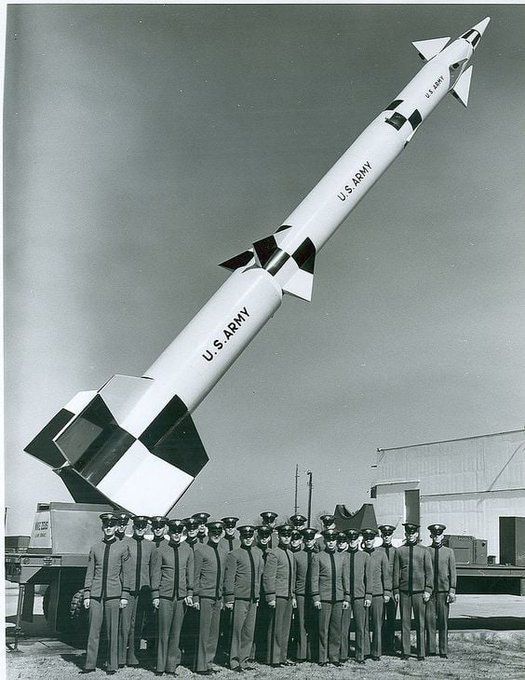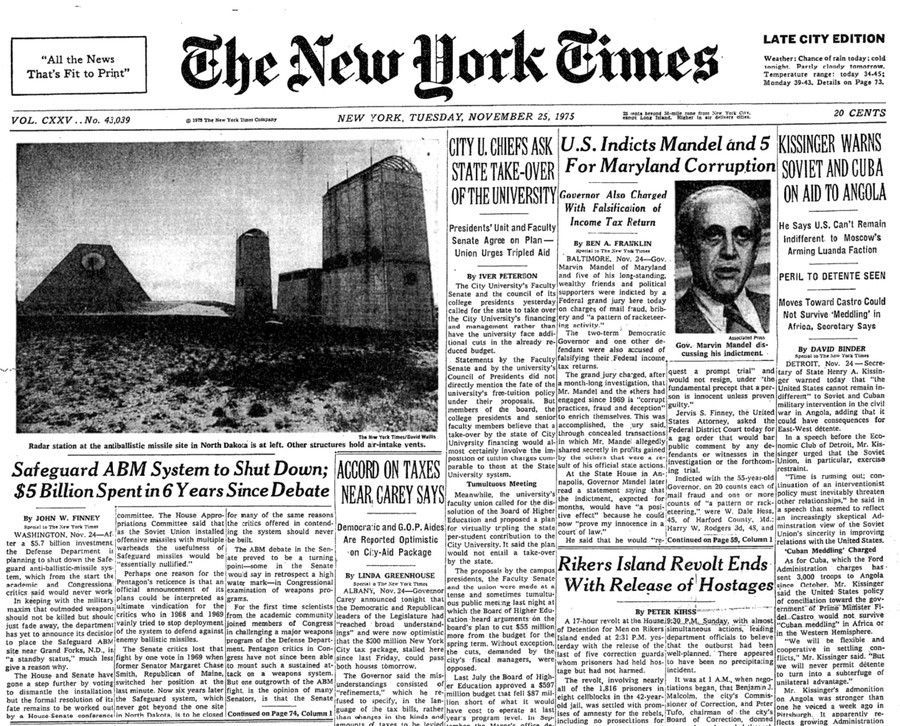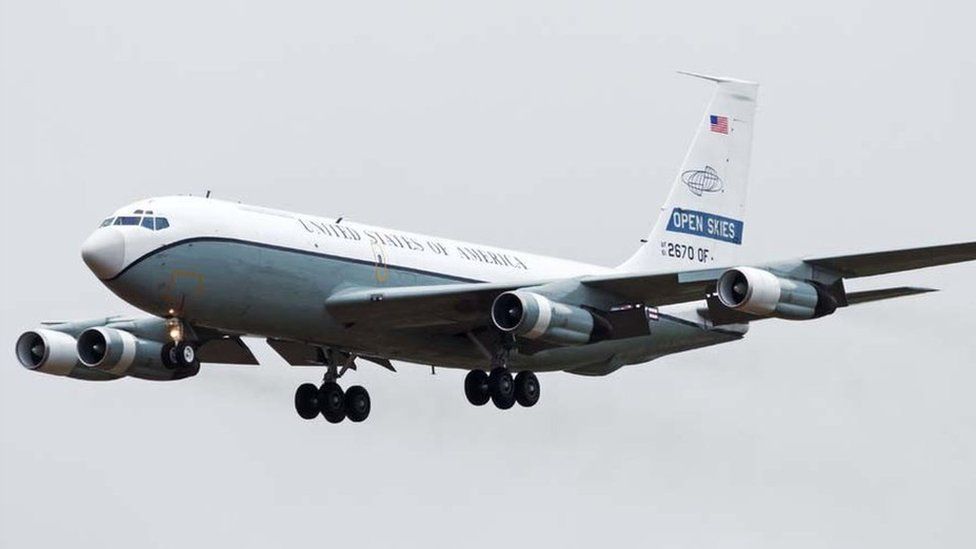
So I walk in the door tonight and this is how one of my cats, Joey, hilariously greets me.
26.11.2025 02:56 — 👍 41 🔁 0 💬 2 📌 1@atomicanalyst.bsky.social
Editor/Co-author, “Atomic Audit: The Costs and Consequences of US Nuclear Weapons Since 1940” • Nonresident Senior Fellow, Bulletin of the Atomic Scientists • Nuclear weapons expert (history, policy, costs, accidents) and tracker of the nuclear “Football.”

So I walk in the door tonight and this is how one of my cats, Joey, hilariously greets me.
26.11.2025 02:56 — 👍 41 🔁 0 💬 2 📌 1

The White House Army aide was on “Football” duty tonight for Trump’s latest trip to his Mar-a-Lago club/home in Palm Beach, Florida. The ~45-pound satchel accompanies Trump 24/7, enabling him alone to authorize the use of any of our ~1,770 deployed nuclear weapons—up to 900 on alert—at any time.
26.11.2025 02:42 — 👍 8 🔁 2 💬 1 📌 0
A color nighttime photograph of a metal sign on a metal post in a parking lot: “Village of Skokie Unauthorized activity is prohibited on village property including civil immigration enforcement activity.”
Skokie takes a stand.
26.11.2025 02:15 — 👍 378 🔁 79 💬 5 📌 5
In July 2022, ND’s then-Gov. Doug Burgum announced Bitzero Blockchain Inc. was buying the long-abandoned Safeguard Missile Site Radar complex in Nekoma for $250,000 to convert it into a mine for Bitcoin and other cryptocurrencies. However, there is no activity and it appears to be for sale again.
25.11.2025 14:05 — 👍 14 🔁 2 💬 1 📌 0
For more about the construction, operation, and deactivation of Safeguard, as well as its local economic and community impacts, watch this video from the State Historical Society of North Dakota:
25.11.2025 14:05 — 👍 16 🔁 1 💬 1 📌 0Safeguard ultimately cost about $42 billion (in today’s dollars), excluding the unknown but considerable billions spent on research, development, testing, and production of the 115 nuclear warheads manufactured by the Atomic Energy Commission for the Spartan and Sprint antiballistic missiles.
25.11.2025 14:05 — 👍 7 🔁 1 💬 1 📌 0
A color, low-level aerial photograph of the Perimeter Acquistion Radar, showing its angled, phased-array face. There is a light covering of snow on the ground
Safeguard was officially shut down on February 10, 1976. The only element not dismantled was the long-range Perimeter Acquisition Radar near Concrete, which acquired and relayed trajectory data on inbound warheads to the interceptors. The Air Force repurposed it as an early-warning radar in 1977.
25.11.2025 14:05 — 👍 9 🔁 1 💬 1 📌 0
An aerial color photograph of the Stanley R. Mickelesen Safeguard Complex at Nekoma, North Dakota, the only operational Safeguard site ever built. The Missile Site Radar is the pyramid-shaped building in the background at center (a cooling pond is behind and to the right). The small square launch area in the foreground contains launchers for 16 Sprint antiballistic missiles. The larger rectangular area immediately behind it contains launchers for 30 Spartan antiballistic missiles.

A black and white photograph of the large Spartan antiballistic missile on display on a truck (possibly at a test range). The black and white missile is pointed toward the sky while a medium-sized group of uniformed male Army personnel (cadets?) pose in front.

A black and white photograph of a Sprint antiballistic missile being loaded from a specialized flatbed truck into a silo in preparation for a test.
Safeguard’s sole purpose was to defend not people but 150 Minuteman ICBMs deployed around Grand Forks Air Force Base in North Dakota. It did this with 30 Spartan (armed with 5-Megaton W71 warheads) and 70 Sprint (armed with 1-kiloton W66 enhanced radiation warheads) antiballistic missiles.
25.11.2025 14:05 — 👍 9 🔁 1 💬 1 📌 0
An article in the November 25, 1975, edition of the New York Times headlined, “Abandonment of Safeguard ABM System Stuns the Town of Langdon, N.D.,” and featuring a large black and white photograph of Mayor John MacFarlane standing, arms crossed, looking at the camera, on Langdon’s main street. A small inset map shows Langdon's location in northeastern North Dakota close to the Canadian border.
John Macfarlane, the 29-year-old mayor of Landgon—home to many of the site’s approximately 1,500 workers and whose economy had become overly dependent on it—said the decision shattered his trust in the federal government. “There ain't nothin’ gonna happen that’ll straighten that out. That’s gone.”
25.11.2025 14:05 — 👍 10 🔁 1 💬 1 📌 0The report came a week after the House of Representatives and the Senate had voted to terminate Safeguard immediately (seven months earlier than the Army intended). Those votes marked the first time that Congress canceled a nuclear weapons program, something that has happened just once since then.
25.11.2025 14:05 — 👍 10 🔁 2 💬 1 📌 0
The front page of the November 25, 1975, edition of the New York Times, featuring an article at the top left headlined, “Safeguard ABM System to Shut Down; $5 Billion Spent in 6 Years Since Debate,” along with a large black and white photograph of the site’s Missile Site Radar and some of the building’s multiple reinforced air intake vents.

The continuation of the New York Times article.
50 years ago today, the New York Times reported that the US Army planned to deactivate the Safeguard antiballistic missile system in North Dakota less than two months after it was declared fully operational, vindicating scientific and congressional critics who had warned it would never be effective.
25.11.2025 14:05 — 👍 38 🔁 14 💬 2 📌 0Also …
24.11.2025 20:58 — 👍 6 🔁 1 💬 2 📌 0“The Party told you to reject the evidence of your eyes and ears. It was their final, most essential command.”
— George Orwell, 1984
This cannot happen soon enough.
24.11.2025 17:11 — 👍 31 🔁 2 💬 1 📌 0I think so, but it was hard to tell for sure from the ground.
23.11.2025 19:50 — 👍 1 🔁 0 💬 0 📌 0
The tower formerly known as Sears, Thursday evening, Chicago.
23.11.2025 19:23 — 👍 28 🔁 1 💬 4 📌 0I feel the need {slap!} the need for radioactive speed.
23.11.2025 00:14 — 👍 9 🔁 0 💬 0 📌 0Sure. Here's the 15-kiloton 1953 GRABLE test, where the warhead exploded 524 feet above the ground. In the first part, you can see the shockwave literally bouncing off the ground and reflecting back into the fireball. One goal of this test was to study blast effects on military equipment.
23.11.2025 00:13 — 👍 3 🔁 1 💬 1 📌 0For British nuclear weapons accidents, see the official 1992 Oxburgh report (especially Annex F, www.nuclearinfo.org/wp-content/u...), BASIC's response to that report (www.nuclearinfo.org/wp-content/u...), and this Ministry of Defense release under FOIA in 2005 (www.nuclearinfo.org/wp-content/u...)
22.11.2025 20:42 — 👍 3 🔁 1 💬 1 📌 0For the Soviet Union/Russia relatively little (apart from several catastrophic Russian submarine accidents). For example: bsky.app/profile/atom..., bsky.app/profile/atom..., bsky.app/profile/atom..., and bsky.app/profile/atom....
22.11.2025 20:42 — 👍 3 🔁 1 💬 2 📌 0
Technically, the military command center shown in "A House of Dynamite" is not the War Room, it's the Battle Deck at STRATCOM.
The War Room—officially the National Military Command Center—is deep inside the Pentagon and looked like this in 1976 (there aren't any public photos after the mid-1980s).
2016 Paris Agreement on climate change, the 2015 Joint Comprehensive Plan of Action on Iran, the 1987 Intermediate-Range Nuclear Forces Treaty, and the Open Skies Treaty. They also failed to extend New START—the last treaty limiting US/Russian strategic nuclear weapons (expires February 5, 2026).
22.11.2025 19:58 — 👍 14 🔁 1 💬 1 📌 0
A color photograph of a US Air Force Open Skies Boeing OC-135B observation aircraft coming in for a landing (note the "OPEN SKIES" designation on the tail).

Copy of a November 22, 2020, US State Department press release of a statement by Cale Brown, principal deputy spokesman: "Treaty on Open Skies On May 22, 2020, the United States exercised its right pursuant to paragraph 2 of Article XV of the Treaty on Open Skies by providing notice to the Treaty Depositaries and to all States Parties of its decision to withdraw from the Treaty, effective six months from the notification date. Six months having elapsed, the U.S. withdrawal took effect on November 22, 2020, and the United States is no longer a State Party to the Treaty on Open Skies."
Five years ago today, the United States officially withdrew from the 1992 Open Skies Treaty, having given notice of its intentions on May 22, 2020, citing spurious Russian “violations” as the reason.
In less than four years, Donald Trump and his unilateralist wrecking crew abandoned the …
And also because all US Navy surface ships, attack submarines, and land-based aircraft have not carried any nuclear weapons since 1992, after President George H.W. Bush unilaterally ordered their removal and retirement in September 1991.
22.11.2025 19:51 — 👍 5 🔁 1 💬 0 📌 0
A Google Maps image showing the former 583rd US Army Ordnance Company storage depot for nuclear weapons (circled in red), situated on forested land near farms and located south of Ostbevern and east of Telgte.

A zoomed-in Google Maps image showing the former 583rd US Army Ordnance Company storage depot for nuclear weapons, situated on forested land near farms to the south of Ostbevern and to the east of Telgte.
The article does not mention nuclear weapons but states that German police were barred from the accident site by military personnel. @okomuenster.bsky.social says a follow-up article a few days later confirmed it was a US CH-47 helicopter (and not a British one, as one source initially reported).
22.11.2025 19:37 — 👍 9 🔁 1 💬 1 📌 0![A copy of an article in the November 23, 1997 edition of Westfälische Nachrichten, under the headline "Keiner worde gestern verietzt Miitärhubschrauber-Absturz in der Nähe von Telgte."
A partial translation (from German):
"Telgte — An eyewitness reported that the helicopter crashed immediately after the take-off maneuver: It is said that it was only thanks to the pilot's flying skills that there were no injuries in the crash of a military helicopter of the type 'Chinnok - CH 47' between Teigte and Ostbovern (Warendorf district). The aircraft took off from the NATO depot at Ostbevern at around 2:20 p.m. Eyewitnesses reported to 'Westfälische Nachrichten' [the local newspaper] that parts of the defective first engine flew to the second engine, which was also damaged. With its snout [front end], the helicopter crashed into a freshly harvested field of farmer Heinrich Elbrich. The field is located on the border between Telgte and Ostbevern just south of the NATO depot. Eyewitnesses reported a small fire that was quickly put out. The people on board remained uninjured. The scene of the accident was hermetically sealed off by military personnel immediately after the crash. Even German police were not allowed, according to the police station at Warendorf. Late in the evening, the 2nd Allied Tactical Air Fleet confirmed at Mönchengledbach that it was a heavy British Transport helicopter. The confirmation of the British Rhine army was not yet available when this newspaper went to print. Different reports said that the helicopter was an American chopper stationed in southern Germany."](https://cdn.bsky.app/img/feed_thumbnail/plain/did:plc:iwbebt5r65c67xl5vy5iviwj/bafkreiczm6gsh6ncdncx2sxxnn5ubhudnoxftxab4g6bdiqryeduwyir2m@jpeg)
A copy of an article in the November 23, 1997 edition of Westfälische Nachrichten, under the headline "Keiner worde gestern verietzt Miitärhubschrauber-Absturz in der Nähe von Telgte." A partial translation (from German): "Telgte — An eyewitness reported that the helicopter crashed immediately after the take-off maneuver: It is said that it was only thanks to the pilot's flying skills that there were no injuries in the crash of a military helicopter of the type 'Chinnok - CH 47' between Teigte and Ostbovern (Warendorf district). The aircraft took off from the NATO depot at Ostbevern at around 2:20 p.m. Eyewitnesses reported to 'Westfälische Nachrichten' [the local newspaper] that parts of the defective first engine flew to the second engine, which was also damaged. With its snout [front end], the helicopter crashed into a freshly harvested field of farmer Heinrich Elbrich. The field is located on the border between Telgte and Ostbevern just south of the NATO depot. Eyewitnesses reported a small fire that was quickly put out. The people on board remained uninjured. The scene of the accident was hermetically sealed off by military personnel immediately after the crash. Even German police were not allowed, according to the police station at Warendorf. Late in the evening, the 2nd Allied Tactical Air Fleet confirmed at Mönchengledbach that it was a heavy British Transport helicopter. The confirmation of the British Rhine army was not yet available when this newspaper went to print. Different reports said that the helicopter was an American chopper stationed in southern Germany."
The location of this DULL SWORD incident was redacted in the report, but a November 23, 1977, article in Westfälische Nachrichten (h/t @okomuenster.bsky.social) says it occurred between Telgte and Ostbevern (near a US depot storing nuclear warheads for British, Belgian, and West German army units).
22.11.2025 19:37 — 👍 8 🔁 1 💬 1 📌 0The CH-47 bounced once and slid about 15 meters. An internal extinguisher put out the fire (reportedly caused by a pine cone sucked into the engine). The warhead shipping containers aboard did not shift, appeared undamaged, and were offloaded and returned to the Army depot by another helicopter.
22.11.2025 19:37 — 👍 4 🔁 1 💬 1 📌 0
A color aerial photograph of a CH-47 Chinook heavy lifting helicopter in flight over mountains, as seen from its right side. The helicopter is painted dark green and features two large rotors forward and aft and four porthole-style windows on its right side.

A difficult-to-read (owing to it being a copy of a copy of a copy), formerly classified, partially redacted November 28, 1977, cable to various army commands in Europe and the United States describing the November 1977 accident involving a CH-47 helicopter transporting nuclear warheads as part of a logistical movement.
Today in 1977, a US Army CH-47 helicopter transporting an unspecified type and number of nuclear warheads from an Army depot near Münster, West Germany, dropped rapidly just after takeoff when its No. 1 engine caught fire, hitting a row of trees and landing hard in a farm field 200-300 meters away.
22.11.2025 19:37 — 👍 18 🔁 5 💬 1 📌 1
Copy of the first page of an undated (circa 1981) Department of Defense report titled, “Department of Defense — Narrative Summaries of Accidents Involving U.S. Nuclear Weapons, 1950-1980."
In response, the Navy insisted, “It is US government policy neither to confirm nor deny the presence of nuclear weapons .... The 1981 Department of Defense report [describing 32 BROKEN ARROWS from 1950-80] is correct in that no nuclear weapons were affected by the 1975 Belknap-Kennedy collision.”
22.11.2025 17:59 — 👍 15 🔁 0 💬 0 📌 0
Copy of an article in the May 25, 1989, edition of the New York Times, “Fire Threatened A Ship’s A-Bombs.”
The accident killed seven sailors on the Belknap and one on the Kennedy. The fact that nuclear weapons were aboard both vessels—and that initially a BROKEN ARROW was a serious concern—was not revealed until May 1989, when researchers at Greenpeace obtained and released declassified Navy documents.
22.11.2025 17:59 — 👍 20 🔁 2 💬 2 📌 0